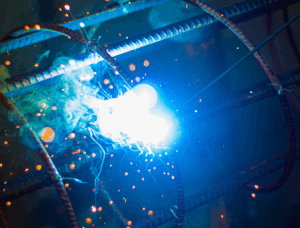Welding is a fundamental process in modern infrastructure development, playing a crucial role in constructing bridges, railways, highways, and skyscrapers. Strong, durable welds ensure the stability and longevity of large-scale projects, supporting economic growth and global connectivity. From high-rise buildings in bustling cities to vast transportation networks spanning continents, welding is at the heart of infrastructure development. Discover how welding supports global infrastructure development, from bridges to railways and skyscrapers. With advancements in technology, tools like Mecaweld’s welding cameras have revolutionized quality control, ensuring precise and defect-free welds in critical projects.
The Role of Welding in Major Infrastructure Projects
Bridges: Ensuring Strength and Longevity
Bridges are vital for transportation, connecting cities, states, and countries. Welding provides the strength required to handle heavy loads, environmental stressors, and extreme weather conditions. Common welding methods used in bridge construction include:
- MIG and Flux-Cored Arc Welding (FCAW) for structural steel components.
- Submerged Arc Welding (SAW) for large steel sections, improving efficiency and consistency.
How Mecaweld Helps:
- Mecaweld’s welding cameras enhance real-time monitoring of weld joints, ensuring flawless execution in critical bridge structures.
Railways: Supporting Global Transportation Networks
Railways are essential for the movement of goods and people across regions. Welding plays a significant role in fabricating railway tracks, train cars, and supporting structures.
- Flash Butt Welding and Thermite Welding are commonly used for joining railway tracks, providing seamless connections that reduce maintenance and increase longevity.
- Welded steel frameworks are essential for train manufacturing, ensuring durability in high-speed and heavy-load conditions.
How Mecaweld Helps:
- Welding cameras detect defects in railway track welds, minimizing the risk of cracks and fractures that could compromise safety.
High-Rise Buildings: The Backbone of Urban Growth
Welding is critical in constructing skyscrapers and commercial buildings, where structural steel frameworks must withstand immense loads and environmental forces.
- Shielded Metal Arc Welding (SMAW) and Gas Tungsten Arc Welding (GTAW) are frequently used for steel frameworks.
- Precision welding ensures that high-rise buildings can endure seismic activities, extreme winds, and high-traffic conditions.
How Mecaweld Helps:
- Weld monitoring technology helps ensure structural steel connections are defect-free, reducing risks in high-rise construction.
Oil and Gas Pipelines: Transporting Energy Across Borders
Oil and gas pipelines require high-quality welds to prevent leaks, corrosion, and structural failures. Pipeline welding demands precision due to high-pressure operations and environmental exposure.
- Automated orbital welding and Gas Metal Arc Welding (GMAW) are commonly used for pipeline construction.
- Weld quality is crucial in preventing environmental disasters and ensuring efficient transportation of resources.
How Mecaweld Helps:
- Real-time weld monitoring ensures pipelines meet industry safety and quality standards, reducing failure risks.
Advancements in Welding Technology for Infrastructure Projects
Robotic Welding for Large-Scale Construction
The adoption of robotic welding in infrastructure projects enhances efficiency, speed, and consistency.
- Robotic systems ensure high-quality welds in bridge components, skyscraper frameworks, and railway construction.
- Automation reduces errors and speeds up the fabrication of large metal structures.
Mecaweld’s Contribution:
- Welding cameras integrated with robotic systems improve accuracy by allowing remote quality inspection and real-time adjustments.
Real-Time Weld Monitoring with Mecaweld
Welding cameras provide live monitoring of the weld pool, helping detect defects early and ensuring compliance with industry standards like AWS and ISO.
- Helps avoid common welding defects such as cracks, porosity, and incomplete fusion.
- Reduces rework costs and improves overall project efficiency.
The Impact of Welding on Sustainable Infrastructure
Eco-Friendly Welding Practices
With increasing emphasis on sustainable construction, welding techniques are evolving to reduce environmental impact.
- Laser welding and friction stir welding generate less waste and consume less energy.
- Advanced shielding gases like argon-helium mixtures improve welding efficiency and reduce emissions.
How Mecaweld Helps:
- Mecaweld’s real-time monitoring systems optimize gas usage, reducing waste and making welding more eco-friendly.
Welding’s Role in Renewable Energy Infrastructure
The rise of renewable energy has increased the demand for high-quality welding in solar farms, wind turbines, and hydroelectric plants.
- Wind turbine towers require precise welding to withstand strong winds.
- Solar panel structures use welded steel frames for stability.
- Hydroelectric dams rely on reinforced welds to handle high-pressure water flow.
How Mecaweld Helps:
- Ensures weld quality in renewable energy infrastructure, improving durability and performance.
Conclusion: How Welding Supports Infrastructure Development
Welding is an indispensable part of global infrastructure development, supporting the construction of bridges, railways, skyscrapers, pipelines, and renewable energy projects. With technological advancements like Mecaweld’s welding cameras, welders and engineers can achieve unmatched precision, safety, and efficiency in critical infrastructure projects.
Looking for cutting-edge welding solutions? Contact Mecaweld today to enhance your welding process with real-time monitoring and advanced quality control.



